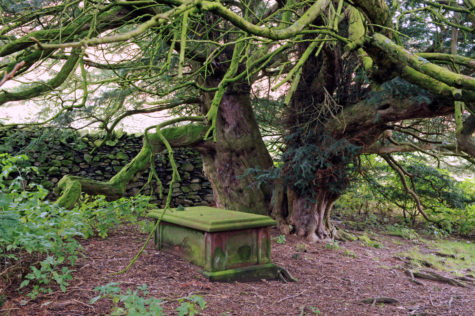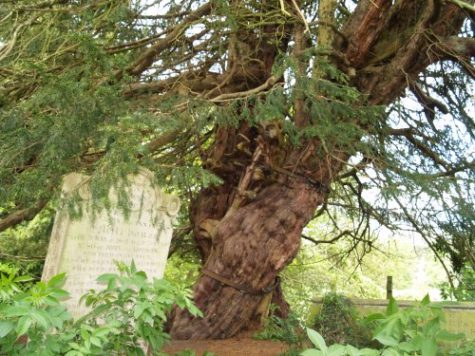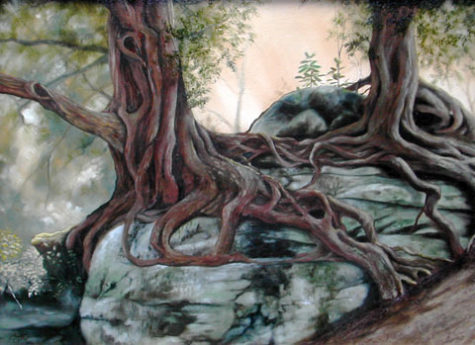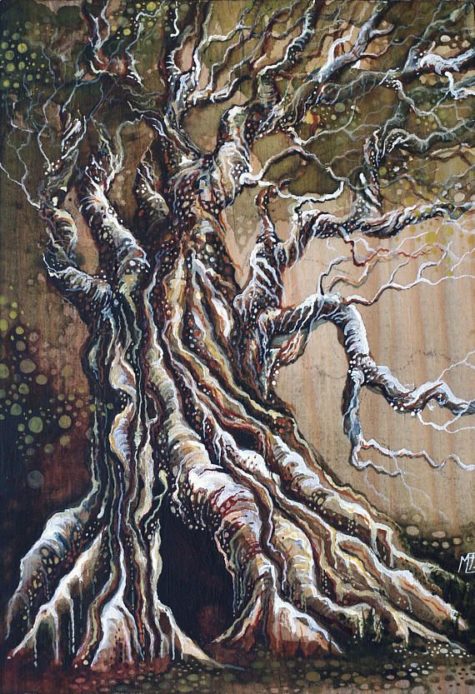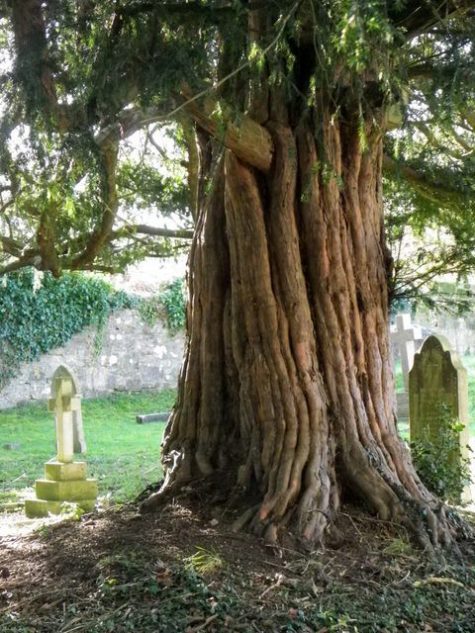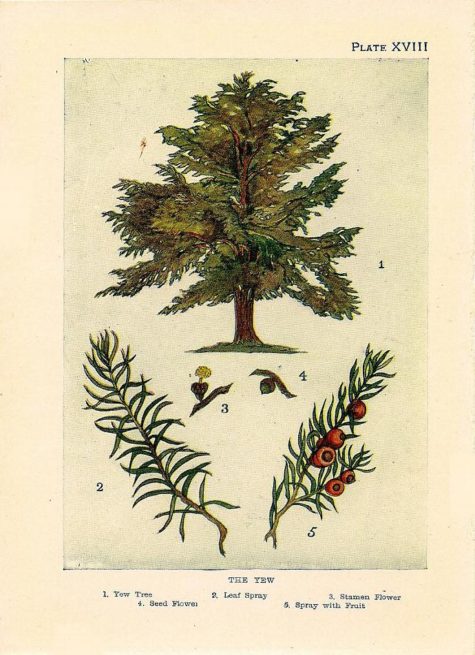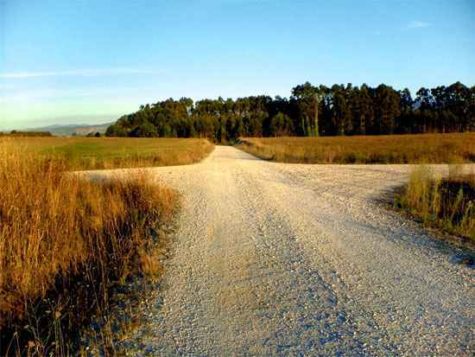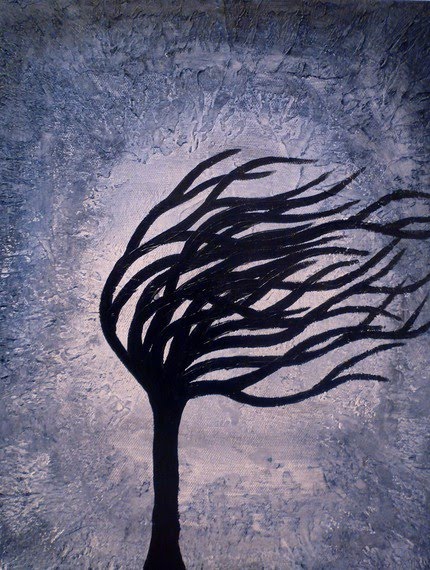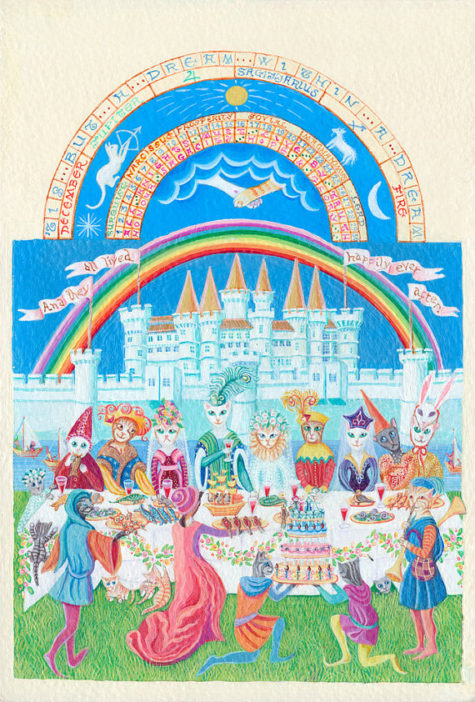Death
- Ruler: Saturn
- Type: Tree
- Magickal Form: Branch and Leaves
- Meaning: Complete change in life-direction or attitude
This is a dark tree, ruled by the Crone. It is used in spells to raise the dead. Yew is also used in ritual to help make the transition into menopause. According to Celtic tree mythology, the Yew is the tree of the day before the Winter Solstice (Approx. December 21).
- Latin name: Taxus baccata.
- Celtic name: Idho (pronounced: Ih’ huh).
- Folk or Common names: English Yew.
The evergreen yew, which lives to an immense age, extending over many generations of men, is a natural symbol of life everlasting, and seems to have been so regarded from time immemorial, alike by pagans and by Christians.
Because of its great longevity, the yew is a symbol of everlasting life. It grows in an unusual way, too, its new stems growing down the outside of the tree, giving the yew an association with rebirth and regeneration, as the new is born from the old. Adding to this symbolism is its habit of putting in a growth spurt when it is around 500 years old.
So sacred was the yew as a symbol that – to a pre-Christian society – wherever it grew was considered to be sacred ground. It was considered both immoral and illegal to chop down the tree. It is likely that the yew is often seen in churchyards because the church itself would have been built on this sacred ground in the presence of the tree, in an effort to align the incoming Christian belief system with pagan traditions.
The association of the tree with death therefore started to overlay its former meaning. Because the berries of the yew are poisonous, they can effectively carry people into the spirit world.
At English country funerals formerly, the mourners often carried branches of yew, which they laid with the dead man in the grave. Small sprigs were also inserted in the folds of his shroud in some districts, before the coffin was nailed down. These typified, not the end of life, but its continuance in the resurrection to come.
Similarly, yew-boughs are usually included today in church decorations at Easter, because they symbolize the triumph of life over death and so are fitting emblems of the Resurrection.
The hollow center of the yew tree is a symbol not only of the power that lies in empty space, but underlines the significance of this tree as belonging, in part, to a spiritual dimension. Recently, the yew as a symbol of life has been shown in a practical and unexpected way. One of the constituent chemicals of the tree, taxol, has been found to be efficacious in curing breast cancer.
Old Ideas About The Yew
In Elizabethan times it was considered an unlucky plant. The Elizabethans tossed sprigs of yew into graves to ensure that the spirits of the dead did not come back to haunt the living.
To cut down a yew tree growing in a churchyard, or to burn or damage its branches, is very unlucky. It is also said to be unlucky to bring yew branches into the house, and most people are careful to omit them from the evergreens used for Christmas decorations.
In the Scottish Highlands, in the days of clan warfare, there was a curious tradition which said that if a chief too a piece of churchyard yew in his left hand, and then denounced or threatened his enemy, the latter, though present, would hear nothing, though all around could hear quite clearly what was said. This presumably, enabled the speaker to claim afterwards that he had given due warning of his intentions, while at the same time retaining the advantages of a surprise attack on a totally unprepared victim.
Although at one time it was considered dangerous to carry a sprig or branch of yew into the home, in Herefordshire, a girl who wished to dream of her future husband went to a churchyard that she had never visited before and plucked a sprig, which she laid under her pillow at night. This would enable her to see her future partner in her dreams.
In the north-midland counties of England, lost goods could be found if the seeker took a branch of yew and held it out before him as he walked. He would be led straight to the place where the lost things were, and when he reached it, the branch would turn in his hand.
The yew is also renowned for protecting homes and other buildings from witches and evil spirits. It is believed that you are likely to die within twelve months if you trim or cut down a yew tree.
Magickal Associations of Yew
Bulls are associated with this tree, as are female goats. The bird associated with Yew is the eaglet, since the eaglet’s appetite is insatiable, and the bones of its nest are white like the snow on its cliff-ledge. The Yews colors are white and silver and it is associated with the element of water. The Yew is associated with the planet Saturn and with the metal lead. In Old England the Yew was known as “The Witches Tree” since it is associated with sorcery and magick.
Magickal usage:
The time of Yew is known as a time of death, and so on the day before Yule it said that is not a good idea to do actual spell work, instead it is suggested to do rituals of the season concerned with reincarnation. Because the Yew grows to such an old age, it has become a symbol of stability in Celtic areas of the world and so is often used as the central “World Tree” in ritual spaces.
As one of the three magickal trees (along the Alder and the Black Poplar) associated with death and funerals, the Yew has often been planted in graveyards. Yew sends up new trees from its roots, so is a powerful symbol of death and reincarnation.
Yew wood is appropriate for magickal tools such as wands and staves. In ancient times Yew sticks were carved with the Ogham characters as tools of divination. The Futhark features a 13th Rune, which is considered one of the most powerful Runes and represents a stave cut from a yew tree. This Rune is regarded as the stave of life and death. Yew can be dried and burned as an incense to contact spirits of the dead – and even to raise the dead.
If you are going to plant a Yew tree, it is best planted in the South-West corner of the property.
Magical History:
The name “Yew” is a corruption of the Anglo-Saxon word ‘eow’. The word ‘Taxus’ is from the Greek word ‘Taxon’, meaning ‘bow’. The 5000 year old “Ice Man”, discovered in the Alps, had a bow and axe handle made of Yew.
The Yew is known as the ‘Tree of Death’ through out Europe and is associated with the season of winter. It is sacred to many Dark Goddesses: Banbha, Amalthea (mother of the horned Dionysus), Morrighan, The Erinyes, Cailleach Beara, Berchta, and Hekate.
Shakespeare recognized the relationship of Yew and Heckate and referred to the contents of her cauldron as “slips of yew, silver’d in the moon’s eclipse…” (Macbeth) – and elsewhere Shakespeare makes ‘hebenon, the double-fatal yew’ the poison which Hamlet’s uncle pours into the king’s ear. Heckate’s sacred tree of death is said to root in the mouths of the dead and release their souls, and also absorbs the odors of death itself.
Yew wood is tough and durable and was used for making shields and spears, and also – using both heartwood and sapwood to gain extra strength – the famous English longbow that helped the English win the Battle of Agincourt in 1415, at which they were completely outnumbered. Hence the yew is also a symbol of the warrior.
Herbal usage:
This plant is poisonous and should never be ingested unless you are 100% sure that you know what you are doing. The needles and branch tips have been used to treat lung diseases and bladder problems. recently a new cancer drug, Taxol, has been derived from its bark and berries.
Sources:
- Encyclopedia of Magickal Ingredients
- Encyclopedia of Superstitions
- Element Encyclopedia of Secret Signs and Symbols
- Dutchie.org
Crossroad is a symbolic term denoting the union and joining of paths. The association of the crossroad with Witchcraft goes back to ancient Greek and Roman times. Classically the crossroad symbolizes a joining of three roads, the balance of opposites, and the meeting of time and space.
In the Aegean/Mediterranean region crossroads were sacred to Hecate, Triformis, and Diana. Ovid, an ancient Roman writer, speaks of Hecate as having three faces with which to guard the crossroads as they branched out. Verro, another ancient writer, equated Diana with Hecate and stated the images of Diana were stationed at the crossroads. Other writers of the period called this goddess Artemis-Hekate, and attributed the mother goddess aspect to her.
The crossroads are likewise associated with the ancestral spirits called Lasa or Lares. These beings were originally thought to be spirits of the forests and meadows, the fairy folk, and spirits of Nature. With development these spirits became associated with the cultivated fields, and eventually the Lara became protectors of the family and home, and associated with the hearth.
Also, in the archaic Roman religion small towers were constructed at crossroads, and an altar was placed before them upon which offerings were laid. Such towers were associated with Nature spirit worship and demarcation. Possibly this may be the foundation of the concept of Watchtowers within modern Witchcraft.
Since classical times the crossroad has been a favored place for Witches to gather because of its link to Nature spirits and the moon goddess. When the symbolic crossroads were Christianized they became symbols of dread. Crossroads become the construction sites for gallows, and suspended cages that contained bodies of criminals. Also, suicide victims, who were not permitted burial in hallowed churchyards, were frequently buried near a crossroad. Then too, the Judaic-Christian Devil was said to hover near crossroads. All of this, of course, helped to defile the sacred grounds where Witches gathered.
Source: The Mystica
The North Wind is the wind of death – but not necessarily that of physical death. This is the realm of the one eternal universal law – change. “Death” here refers to the elimination of negativity.
The North Wind is cold (magically speaking), blowing in as it does from the direction of winter and of snows lying deep across the lands. It is “dry,” or barren, thus paving the way for spells of destruction.
How to use it? If you are depressed, anxious, envious, jealous, angry, and the wind is blowing from the north face full into it and it will free you of these things.
If you wish to break a bad habit, perform any spell of this nature while the North Wind is blowing for added power.
The North wind, while chilly with night and death and deep snows, is also the wind of the element Earth, and thus shares in some of its qualities. But the wind, being dry, is not favored for fertility and prosperity magic, although that involving healing can be greatly aided by the North Wind.
Its color is the black of midnight.
From: Earth Power
- Nature Spirits: Snow faeries, Storm faeries, Winter Tree Faeries
- Herbs: Holly, English Ivy, Fir, Mistletoe
- Colors: Blood Red, White and Black
- Flowers: Holly, Poinsettia, Christmas Cactus
- Scents: Violet, Patchouli, Rose Geranium, Frankincense, Myrrh, Lilac
- Stones: Serpentine, Jacinth, Peridot
- Trees: Pine, Fir, Holly
- Animals: Mouse, Deer, Horse, Bear
- Birds: Rook, Robin, Snowy Owl
- Deities: Hathor, Hecate, Neith, Athena, Minerva, Ixchel, Osiris, Norns, Fates
Power Flow:
To endure, die and be reborn. Earth tides turning. Darkness. Personal alchemy. Spiritual paths, Reach out to friends and family, the lonely and needy.
From: Moon Magic
Art by Jane Haworth
